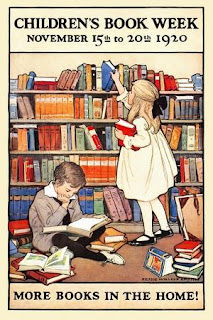Welcome!
Wednesday, May 25, 2022
An (accidental) Book Expotition in Kansas City - Part Two
Monday, May 23, 2022
A Book Expotition in Kansas City - Part One
 |
| A Sample of Children's Book Week Posters From left to right - Jessie Wilcox 1924, Kate Seredy 1962, Lane Smith 1995 From Left to Right - Jan Brett 1996, Kevin Henkes 2002, Jon J. Muth 2010 |
Saturday, May 14, 2022
A Collector of Books
“I am a dragon. And this is my hoard.”
“You… don’t look like a dragon.”
“Well, hardly anyone does, these days. Times have changed, we have too. The scales and tails thing worked with the dinosaurs, but we learned quite quickly that… that wasn’t going to fly with you people.”
“You were around all the way back to the dinosaurs?”
“Well, not like… me personally. How old do you think I am?”
“… There’s no safe answer to that.”
“No.”
“So… when you say this is your hoard…?”
“All dragons have them. Some stick to the old gold and jewels thing, but that’s so cliché these days. Most of us like our hoards to be a little bit more sophisticated than ‘shiny.’“
“Like what?”
“I have known dragons to collect snowflakes from the first fall of the year over dozens of centuries. I know dragons that collect petals of flowers left on the graves of loved ones. Dragons that keep and care for soft toys and comfort items, left behind as children grow up. Dragons that guard happy memories and shards of sunlight, kept safe for rainy days. And me, I keep a sanctuary of words. A bastion of language, of poetry. Of written music and achingly beautiful prose. I am the Guardian of this monument to linguistic majesty. I collect stories of love and life and death and mourning and joy. There is nothing more beautiful in all the world, no coin or gem or sliver of starlight more fantastic than a well-told tale. A story is this world’s truest treasure, and what better chest for it than a book?”











